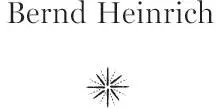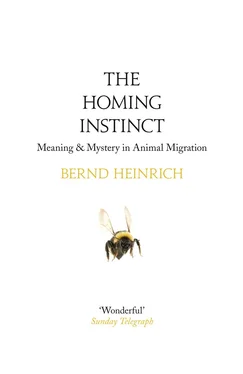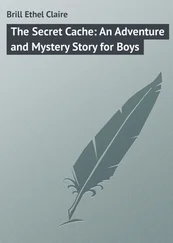Meaning and Mystery in Animal Migration

William Collins
An imprint of HarperCollins Publishers
1 London Bridge Street
London SE1 9GF
WilliamCollinsBooks.com
This eBook first published in Great Britain by William Collins in 2014.
First published in hardback in the US by Houghton Mifflin Harcourt 2014.
Text and illustrations copyright © Bernd Heinrich 2014
Cover photograph © Antagain / Getty Images
The author asserts his moral right to be identified as the author of this work.
A catalogue record for this book is available from the British Library.
All rights reserved under International and Pan-American Copyright Conventions. By payment of the required fees, you have been granted the non-exclusive, non-transferable right to access and read the text of this e-book on-screen. No part of this text may be reproduced, transmitted, down-loaded, decompiled, reverse engineered, or stored in or introduced into any information storage and retrieval system, in any form or by any means, whether electronic or mechanical, now known or hereinafter invented, without the express written permission of HarperCollins.
Source ISBN: 9780007594054
Ebook Edition © August 2014 ISBN: 9780007594061
Version: 2015-04-22
CONTENTS
Cover
Title Page
Copyright
Preface
Introduction
I. HOMING
Cranes Coming Home
Beelining
Getting to a Good Place
By the Sun, Stars, and Magnetic Compass
Smelling Their Way Home
Picking the Spot
II. HOME-MAKING AND MAINTAINING
Architectures of Home
Home-making in Suriname
Home Crashers
Charlotte II: A Home Within a Home
The Communal Home
III. HOMING IMPLICATIONS
The In and Out of Boundaries
Of Trees, Rocks, a Bear, and a Home
On Home Ground
Fire, Hearth, and Home
Homing to the Herd
Epilogue
Further Reading
Index
Acknowledgments
Books by Bernd Heinrich
About the Publisher
ABOUT A DECADE AGO I STARTED PULLING TOGETHER BITS and pieces on the “homing” topic and in 2011 had a book manuscript scheduled for publication. I was then living at “camp” in Maine, where I had done my fieldwork on bumblebees for years; lately my work involved feeding ravens with cow carcasses in the winter, and I then got interested in beetles that bury mouse carcasses in the summer. Soon the topic of recycling of animal carcasses of all sorts seemed more urgent than the scheduled book about getting to and living in a particular place. So, I put writing about homing on hold. By the time I again picked up my pencil, it seemed as though everything I thought of or had an interest in had, in one way or another, started to have a bearing on home and homing. In the meantime I had also been confronting personal issues of “homing,” and they seemed to take on increasingly similar forms to what I was reading about in animals.
I had already left my academic position in Vermont and wanted to return home to live in Maine, possibly in the home to which I had bonded strongly as a child. I had planted a row of trees there about thirty-five years ago. Those trees, now huge, brought back many memories related to them. They reminded me of my father, who had liked them, probably because he had strong feelings for a row of chestnut trees that also lined the way to his old home in the old country that he had often talked about. Because I had written a book about my father, and not also one about my sisters or my mother, I had come into the disfavor of both. There had been parent-offspring conflict before my mother died, and then the house stood empty. So then there was also sibling rivalry over the estate. It seemed like being in a real-life situation of the sociobiology theories, in an almost perfect rendition of a naked mole rat colony where one of the family finds a big tuber, and the others claim it as theirs, and then a vocally assertive member establishes herself as the matriarch. I realized then that the difference between what can happen to a human and to a naked mole rat family is mainly one of terminology. This thus provided the topic of home and homing a much wider perspective.
Our passionate preoccupation with the sky, the stars, and a God somewhere in outer space is a homing impulse. We are drawn to where we came from.
— Eric Hoffer
With all things and in all things, we are relatives.
— Native American (Sioux) proverb
I LEANED ON THE SHIP’S RAILING AT THE STERN, A TEN-YEAR-OLD boy with virtually no notion of where my family might be going. I heard the deep roar of the engines, the whine of the wind, and the rush of the churning water. I felt adrift, as though carried along like a leaf in a storm, feeling the rocking, the spray, and the endlessness and power of the waves. I had no notion that we were among multitudes who had made hard decisions to court the great unknown, or any clear idea of why my family had left the only home I’d known in a forest in Germany. The only picture of what our new home might be was that we might find magical hummingbirds, and fierce native tribes armed with knives, bows and arrows, spears, and tomahawks.
Security for me was the memory of where we had come from, specifically a little cabin in the woods and a cozy arbor of green leaves that enclosed me like a cocoon where I could see out but nobody could see in. It meant a feeling of kinship with the tiny brown wren with an upright stubby tail that sang so exuberantly near its snug feather-lined nest of green moss hidden under the upturned roots of a tree in a dark forest. I had in idle moments in my mind inhabited that nest. I found, too, the nest of an equally tiny long-tailed tit. This little bird’s home was almost invisible to the eye because it was camouflaged with lichens that matched those on the thick fork of a tall alder tree where it was placed.
The ocean all around was a spooky void. But then, after several days at sea, a huge white bird with a black back appeared as if out of nowhere, and it followed us closely. I saw its dark expressionless eyes scanning us. It was an albatross. It skimmed close over the waves and sometimes lifted above them, circled back, and then picked up momentum to again skim alongside our boat. It followed us for hours, maybe even days.
The albatross was big and flew without beating its wings. Years later I wondered if, even in the featureless open ocean where so much looked the same every hour and every day, it may have known where it was all along. How do we find our home and recognize it when we find it? These questions were inchoate then, but given the examples of other animals, they put many ideas of home and homing in context.
Later, as a graduate student, I read that pigeons could return home to their loft even when released in unfamiliar territory, and that some other birds could navigate continental distances using the sun and the stars. There were few answers to how they did it. But I read about researchers at Cornell University who attached magnets to the heads of pigeons and got them all confused. Donald Griffin, my scientific hero (who had discovered how bats can snatch silent moths out of the air in a totally dark room that had wires strung all over the place), was releasing seagulls over forest where they could never have been before and then tracking the birds’ flight paths by following them in an airplane. Most of his birds turned in circles before some of them flew straight, although why was not clear. Searching for a thesis problem to work on, I wrote to ask him if birds passing through clouds might keep in a straight line by listening to the calls flocks make while migrating. He replied in a long, thoughtful letter to let me know that this idea was too simplistic, and that one should not discount much more complicated mechanisms. That was excellent advice. I did not then have the means to solve any of these puzzles, but over the years I have kept in touch with the evolving field of animal navigation and its relevance to the need for a home.
Читать дальше













